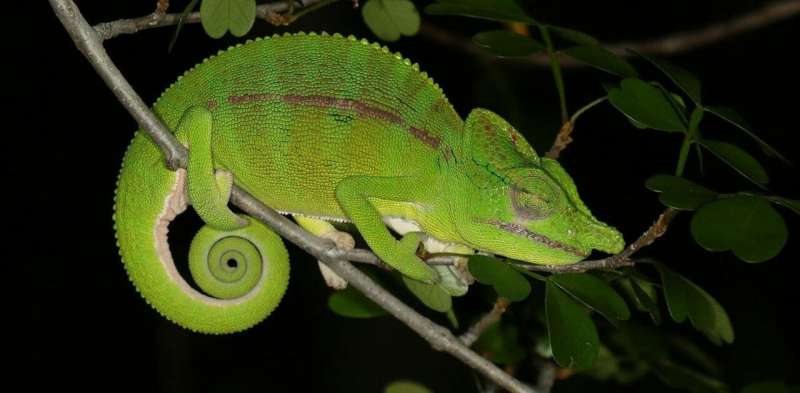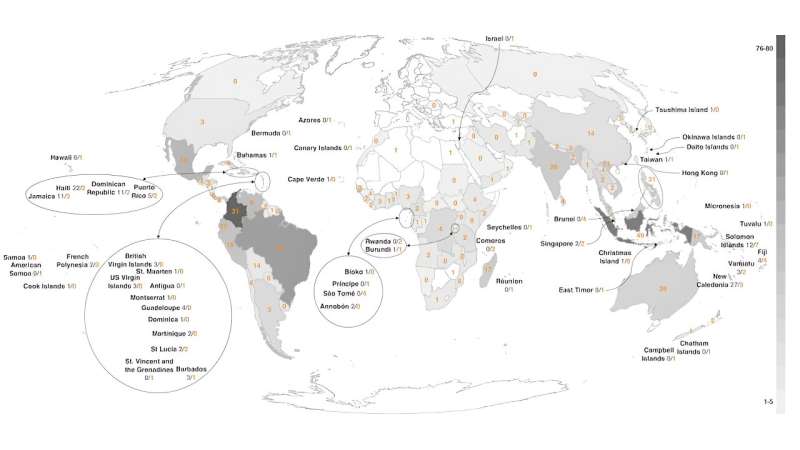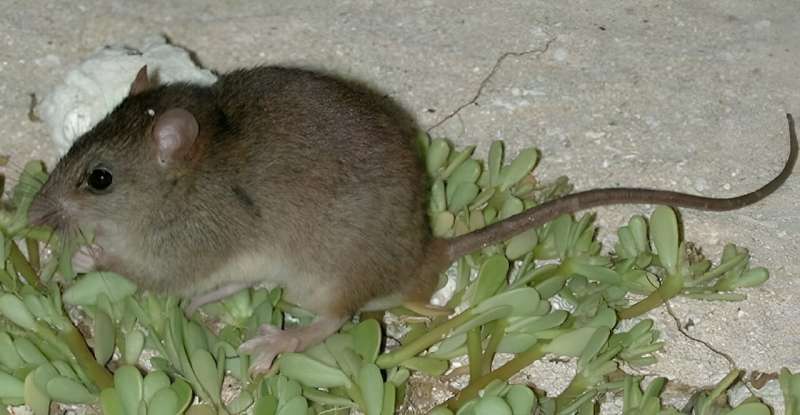This article has been reviewed according to Science X's editorial process and policies. Editors have highlighted the following attributes while ensuring the content's credibility:
fact-checked
peer-reviewed publication
trusted source
written by researcher(s)
proofread
We are losing tetrapod species at a faster rate than we are rediscovering them, researchers say

Lost species are those that have not been observed in the wild for over 10 years, despite searches to find them. Lost tetrapod species (four-limbed vertebrate animals including amphibians, birds, mammals and reptiles) are a global phenomenon—there are more than 800 of them, and they are broadly distributed worldwide.
Our research, published today in the journal Global Change Biology, attempts to pin down why certain tetrapod species are rediscovered but others not. It also reveals that the number of lost tetrapod species is increasing decade-on-decade. This means that despite many searches, we are losing tetrapod species at a faster rate than we are rediscovering them. In particular, rates of rediscovery for lost amphibian, bird and mammal species have slowed in recent years, while rates of loss for reptile species have increased.
This is not good news. Species are often lost because their populations have shrunk to a very small size due to human threats like hunting and pollution. Consequently, many lost species are in danger of becoming extinct (in fact, some probably are extinct). However, it is difficult to protect lost species from extinction because we don't know where they are.
Rediscoveries lead to conservation action
In 2018, researchers in Colombia successfully searched for the Antioquia brush-finch (Atlapetes blancae), a bird species unrecorded since 1971. This rediscovery led to the establishment of a reserve to protect the remaining population of the brush-finch, which is tiny and threatened by habitat loss caused by agricultural expansion and climate change.
The Victorian grassland earless dragon (Tympanocryptis pinguicolla) was rediscovered in Australia last year. It hadn't been recorded for 54 years, and was presumed to be extinct, due to the loss of its grassland habitat and predation by invasive alien species including feral cats. Its rediscovery resulted in government funding to trial new survey techniques to find further populations of the species, a breeding program, and the preparation of a species recovery plan.
Thus, rediscoveries are important: they provide evidence of the continued existence of highly threatened species, prompting funding for conservation action. The results or our study may help to prioritize searches for lost species. In the image below, we mapped their global distribution, identifying regions with many lost and few rediscovered species.

What factors influence rediscovery?
Sadly, many quests to find lost species are unsuccessful. In 1993, searches in Ghana and the Ivory Coast over seven years failed to rediscover a lost primate, Miss Waldron's red colobus (Piliocolobus waldronae). The research team concluded that this noisy and conspicuous monkey, unrecorded since 1978, may well be extinct. Its demise has been caused by hunting and the destruction of its forest habitat. Further searches in 2005, 2006 and 2019 were also unsuccessful, although calls that were possibly by this species were heard in 2008.
In 2010, searches for the Mesopotamia beaked toad (Rhinella rostrata), unrecorded in Colombia since 1914, were unsuccessful (but did lead to the discovery of three new amphibian species). Last year's search for the Sinú parakeet (Pyrrhura subandina), unrecorded in Colombia since 1949, was also unsuccessful. Nevertheless, the project team did identify the presence of ten other parrot species in the survey area and large tracts of suitable habitat, giving hope for the continued existence of the Sinú parakeet.
So why is it that some species are rediscovered while others remain lost? Are there specific factors that influence rediscovery? We aimed to answer these questions in our study, in order to improve our ability to distinguish between the types of lost species we can rediscover, from those that we cannot, because they are extinct.
Our project team comprised members of the organization Re:wild, which has been leading efforts to search for lost species since 2017, along with species experts from the International Union for Conservation of Nature (IUCN) Species Survival Commission (SSC).
We compiled a database of 856 lost and 424 rediscovered tetrapod species (amphibians, birds, mammals and reptiles). We then proposed three broad hypotheses about factors that might influence rediscovery: characteristics of (i) tetrapod species, and (ii) the environment influence rediscovery, and (iii) human activities influence rediscovery.
For example, body mass (a species characteristic) may positively influence rediscovery, as larger lost species should be easier to find. Lost species occupying dense forests (a characteristic of the environment) may not be rediscovered as searching for them is difficult. Lost species affected by threats associated with human activities (e.g., invasive alien species, which are being spread to new locations by global trade) may not be rediscovered, as they may be extinct.
Based on these hypotheses, we collected data on a series of variables associated with each lost and rediscovered species (for example, their body mass), which we then analyzed for their influence on rediscovery.

Hard to find + neglected = rediscovered
On the upside, our results suggest that while many lost species are difficult to find, with some effort and the use of new techniques, they are likely to be rediscovered. These species include those that are very small (including many lost reptile species), those that live underground, those that are nocturnal, and those living in areas that are difficult to survey.
In fact, since the completion of our study, De Winton's Golden Mole (Cryptochloris wintoni) has been rediscovered in South Africa. This species hadn't been recorded in the wild since 1937. It lives underground much of the time, so searches were conducted using techniques including environmental DNA and thermal imaging.
Our results also suggest some species are neglected by conservation scientists, particularly those that are not considered to be charismatic, such as reptiles, small species and rodents. Searches for these species may also be rewarded with success. Voeltzkow's chameleon (Furcifer voeltzkowi), a small reptile species, was rediscovered in Madagascar in 2018.
Lost or extinct?
Unfortunately, our results also suggest that some lost species are unlikely to be found no matter how hard we look, because they are extinct. For example, remaining lost mammal species are, on average, three times larger than rediscovered mammal species. Some of these large, charismatic, conspicuous species should have been rediscovered by now.
Furthermore, one third of remaining lost mammal species are endemic to islands, where tetrapod species are particularly vulnerable to extinction. The Bramble Cay melomys (Melomys rubicola), which was once considered to be a lost species, has recently been declared extinct by the Australian Government. It occupied a small island that has been extensively surveyed—if it still existed it should have been rediscovered by now.
Lost bird species have, on average, been missing for longer than those that have been rediscovered (28% have been missing for more than 100 years), and many have been searched for on several occasions—perhaps some of these species should also have been rediscovered by now.
Nevertheless, unexpected rediscoveries of long-lost species like the Cebu flowerpecker (Dicaeum quadricolor) do occur, so we shouldn't lose hope, and we should definitely keep searching. However, some searches are being carried out for long-lost species that are considered to be extinct, such as the thylacine (Thylacinus cynocephalus). Perhaps the limited resources available for biodiversity conservation would be better used to search for lost species likely to still exist.
More information: Tim Lindken et al, What factors influence the rediscovery of lost tetrapod species?, Global Change Biology (2024). DOI: 10.1111/gcb.17107
Journal information: Global Change Biology
Provided by The Conversation
This article is republished from The Conversation under a Creative Commons license. Read the original article.![]()




















